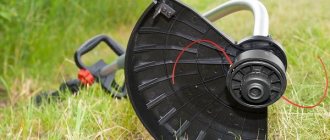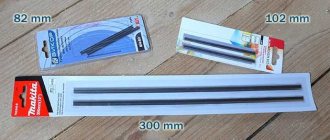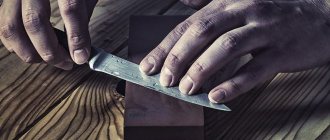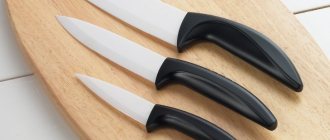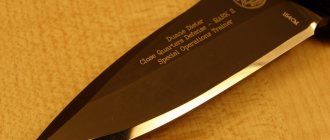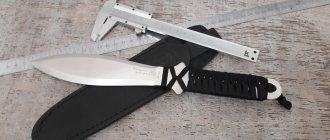When creating hairstyles, the blades in a hair clipper gradually wear out. For this reason, the speed, quality and productivity of work decreases. The efficient operation of the equipment is restored by sharpening the parts.
Hair clipper
The highest quality sharpening of hair clippers is done using professional equipment. However, there are ways to do this work at home. Let's look at the most common of them.
When do knives need to be sharpened?
However, sooner or later, home hairdressers are faced with a serious problem when the blades of hair clippers become so dull that it becomes simply impossible to do a normal hairstyle. There are two ways to solve this problem. Buy a new machine or try sharpening the blades yourself. The second option looks preferable, since there are at least four effective methods that allow you to sharpen any cutting surface yourself.
Modern trimmers are equipped with steel or ceramic knives, the cutting part of which is often coated with a protective layer of diamond, titanium or carbon coating. However, even such durable blades lose their sharpness with frequent use, which leads to the following problems:
- straightening your hair becomes very difficult;
- while cutting, the cutting part of the device begins to tug and wrinkle the hair, causing unpleasant pain;
- At the end of the procedure, the skin on the head is severely irritated, up to small cuts.
There are several ways to fix this problem, but they all start with disassembling the machine:
- disconnect the knife block from the body;
- unscrew the screws;
- separate the blades;
- We clean the cutting and working parts from dirt and hair residues using a special brush or a clean rag soaked in water.
Attention!!!
The process of disassembling the trimmer should be filmed on a mobile phone camera so that when assembling this household unit there are no “extra” parts left. After disassembling the cutting unit and cleaning the blades - a process that should be done after every haircut - you can move on to one of four effective types of sharpening.
Tool operation
The machine must be stored in a dry place. After each haircut, the working unit must be blown out and wiped with alcohol or vodka. Dry. The less dirt gets into the trimmer mechanism, the less often the blades need to be sharpened.
When the first signs of dullness occur, the tool should be disassembled, washed, lubricated and tested. If there is no one to cut your hair, experts advise trying to cut natural fur. An old coat collar and some skin scraps will do. If cleaning does not help, you need to disassemble the tool and sharpen the knives.
Using a grinder
This method requires increased caution, as well as the presence of stationary or manual grinding equipment:
- We press the removed and cleaned knives with the cutting part to the grinding wheel;
- turn on the machine;
- sharpen the blades to a mirror shine;
- clean the knives (it is better to rinse) from abrasive materials;
- We assemble the cutting unit and install it on the machine.
Disadvantages: labor-intensive process, expensive equipment and not the highest quality.
Cleaning the blades
Cleaning knives is an important aspect of the procedure. For self-sharpening razors, it is enough to remove hairs and rust from the knives and lubricate the cutting edge - and the quality of the haircut will noticeably improve.
- The knife block must be separated from the main body, unscrew the mounting screws, and separate the blades.
- Using a cloth (you can use a soft brush), carefully clean the metal surfaces of the knives.
- To remove rust, the blades are immersed in a special solution (you can use a 9% acetic acid solution) for several minutes.
We recommend: How and with what can you clean an ultrasonic humidifier?
Then, after drying, you can begin sharpening.
Using a whetstone
With this method, you need a double-sided block, one side of which is intended for direct sharpening, and the other for final finishing:
- Place the whetstone on a flat surface with the “rough” side up;
- secure the blade using a magnetic holder;
- smoothly and without much pressure we move the cutting part of the knife at an angle of 30 to 45 degrees (depending on the manufacturer) from one edge to the other of the block at least seven times;
- turn the block over with the fine-grained side up;
- We carry out the final finishing of the blades to a mirror shine;
- thoroughly wash, dry and install the lubricated knives on the machine.
Disadvantages: a rather labor-intensive process and not an ideal result. However, this method is more effective than sharpening on a grinding machine.
How to sharpen knives on a clipper with sandpaper?
If the machine is not very dull, you can deal with it using regular sandpaper with a fine abrasiveness. Buy a skin with a fine grain size of 4000 grit.
Instructions:
- You need to run the sandpaper between the blades and turn on the machine at maximum speed. Hold for a few seconds and repeat the manipulation. This procedure will help sharpen the knives slightly.
- After this, the device is disassembled, cleaned from rust, dust residues, and possibly pieces of sandpaper. If the machine is very dull, then you need to use another method. If you don't have any special tools, glass or a mirror is ideal.
- To do this, take thick glass and apply abrasive paste on it, which can be purchased at any store that sells glasses. This kind of paste is used to polish microscope lenses and glasses. The paste is applied to the glass, the blade is inserted into the magnetic holder and securely fixed.
- After this, circular processing of the machine blades is carried out. It is necessary to work in a circle until the blades acquire the sharpness that you need. The remaining paste is removed under strong pressure of water and removed using flannel.
Hair clipper
After carrying out such manipulations, you will be able to return your hair clipper to its former life, as well as make your hairstyle perfect. If you are not confident in your abilities, we recommend taking the device to a workshop and sharpening it there. Because such devices can be quite expensive, you should not risk their performance.
On a professional machine
This option is more suitable for hairdressers whose working tools require regular – at least 4 times a year – and high-precision sharpening. At the same time, the high quality of this process can only be ensured by a special machine, which significantly reduces the time for this procedure.
The algorithm of actions in this case looks like this:
- remove the knives from the trimmer;
- cover the sanding disc, cleaned of dust and dirt, with an even layer of abrasive paste;
- fix the knife on the magnetic holder with the cutting edge down;
- we start the machine at a certain speed (indicated in the instructions);
- We bring the knife to the wheel and begin the sharpening process, using smooth movements of the blade, the teeth of which should be directed against the movement of the grinding disc, from the edge to the central part.
The main disadvantage of this method is the high cost of a professional machine and consumables.
Sharpening rules
Rule one: when sharpening knives, you should not skimp on the device or tool that will be used to carry out the procedure, because the worse it is performed, the sooner it will need to be repeated again. The second important rule is compliance with safety precautions. Sharp blades are easy to cut, so they need to be carefully secured when sharpening, and then carefully set in place when reassembling .
Tools
A variety of tools are used to restore the sharpness of blades. Experts recommend purchasing professional sharpening kits, but sharpening stones, sandpaper, lathes, grinders, drills or grinders are also suitable. Depending on the chosen device or material, the method of carrying out the procedure also changes.
Sharpening with sandpaper
If the machine is not used in a hairdressing salon, but at home, it is not advisable to purchase special tools or sharpening kits. You can sharpen knives with simple sandpaper, for which you will need:
- a sheet of 800 grit sandpaper;
- a sheet of sandpaper for polishing with grit from 3000 to 8000;
- a cup of water in which to rinse the blade.
Sheets of sandpaper are laid on plywood or glass, always with a flat surface.
Advice! It is not recommended to perform the operation on the table, as there may be bends, ovals and other defects on it that will prevent the knife from being properly sharpened and polished.
Procedure.
- It is necessary to place a sheet of coarse sandpaper (800) on the surface, moisten the blade and, pressing it to the sheet, sharpen it with up and down movements. Periodically you need to dip the part in water for better processing and rinsing off metal chips. Once the nicks and defects are mostly removed, you can proceed to the next step.
- Before polishing, you should thoroughly rinse the knife under running water to remove large chips that could deform the surface again.
- Next, you need to change the sheet of coarse sandpaper to fine sandpaper and repeat the above procedure (step 1) to polish the blade. The process can be stopped when the blade is perfectly smooth and sharp.
As you can see, the procedure can easily be performed independently.
Sharpening with a whetstone
Sharpening knives with a whetstone is similar to the procedure described above. It will require a double-sided sharpening stone, one surface of which is intended for the main work, and the second for grinding .
The knife must be secured with a magnetic holder, and then the sharpener must be drawn along the blade five to seven times, observing the angle of inclination of the cutting part established by the manufacturer. As a rule, it varies from 30° to 45°. Next, the knife must be thoroughly rinsed under high pressure water to wash away the crumbs, and then sanded with the side of a fine-grained stone. After completing the procedure, the blades should be washed and wiped dry.
Important! If the machine has ceramic blades, they can only be sharpened with a diamond-coated whetstone. Otherwise, there is a high risk of damaging the knives.
Sharpening with a special set
If the clipper is constantly used for professional purposes, the knives must be sharpened regularly. In this case, it is advisable to buy and use a special kit that easily prepares the cutting part of the working tool for use. The set includes:
- machine with a protective cover;
- aluminum disk;
- lubricating oil;
- abrasive paste;
- magnet;
- cleaning agent.
To carry out the process, you need to perform the following algorithm of actions.
- Disassemble the machine, remove the cutting unit, disconnect the blade.
- Prepare the machine for use: wipe off dust, lubricate thoroughly.
- Apply abrasive paste. You can use your fingers for this, wearing latex gloves for protection. You need to apply several strips evenly along the radius to the disk, and then distribute the mass over the entire circumference.
- Secure the knife with a magnet as described in the instructions. The blade is sharpened against the direction of rotation of the disc - if it rotates clockwise, the teeth of the knife should be turned to the left, and vice versa. The knife itself is directed sideways towards the middle of the disc.
- Start the machine, set the desired rotation speed, bring the knife and sharpen it, pressing the blade and directing the part from the edge to the central part of the circle.
- Turn off the machine, separate the cutting element from the magnet.
- Wash the blades thoroughly in a cleaning solution to remove any metal chips and paste.
- Thoroughly wipe the knives with a rag.
- Reassemble the machine in reverse order.
When performing the procedure, the blades must be turned in the direction opposite to the direction of rotation of the disk . It is not recommended to rush when working. The standard procedure usually lasts up to two minutes. Haste and careless work can damage the cutting part.
Sharpening with a lathe
If you have an electric lathe at home, it will greatly simplify the process of sharpening knives. All you need is skills to operate this device. To perform the procedure, you need an aluminum disc and abrasive paste or powder. Next you need to do the following:
- install an aluminum circle on the machine, clean it from dirt;
- apply powder or paste to the circle;
- set the required wheel rotation speed (no less than 1200 and no more than 1500 rpm), turn on the machine;
- sharpen the knives, then wash and dry them thoroughly.
When working on a lathe, it is recommended to follow safety standards.
Important! When sharpening knives on a lathe, you need to use goggles to protect your eyes, and gloves to protect your hands. During the sharpening process, you should keep a certain distance from the tool.
Sharpening with a grinder
Stationary and manual grinding machines can also be used for sharpening. The process is very simple - remove the knives from the device, start the grinder and, pressing the cutting part against the moving wheel, sharpen the blades, then rinse them thoroughly. You need to work carefully so as not to get hurt. This method is criticized by some professionals, but sharpening is still faster than using a simple whetstone.
Sharpening with a grinder or drill
Sometimes a drill or grinder is used for sharpening. To do this, install a grinding attachment with fine grain on the drill, and a similar grinding wheel on the grinder. Next, pressing the blades against the tool, you need to sharpen. You need to work very carefully, wearing glasses and gloves.
Features of sharpening clippers for animals
Conventional clippers are not suitable for cutting dogs, sheep or other animals. This can be explained by the fact that the fur of animals is coarser than the hair of people. To solve such problems, a cutting power tool of a different design is used. In cases where animal grooming has to be done regularly, often purchasing blades or sharpening them from specialists will be expensive and inconvenient. Such difficulties concern owners of a large number of sheep or various breeds of dogs with long hair.
To solve the problem and sharpen your tools, you can use the methods described above. But you need to take into account that sandpaper, a sharpening stone, a grinder and other tools and devices must have a fine-grained surface. The process itself is identical to the procedures described above, and difficulties, if they arise, in most cases will be associated with the shape of the cutting parts. But after several procedures, experience will accumulate, and problems will not arise.
Adjustment
Each of these four options for sharpening hair clipper blades is available at home. However, even perfectly sharpened blades will not work correctly if they were installed without adjustment when assembling the cutting part:
- the serrated edge of the upper blade should be shifted 1-2 millimeters horizontally relative to the serrated edge of the lower knife;
- the cutting part of the first tooth of the moving knife in the longitudinal plane is in line with the serrated edge of the stationary blade.
The service life of a modern trimmer can really be significantly extended. To do this, you need very little - remove, remove dirt and lubricate the blades after each haircut, and also master simple techniques for sharpening and adjusting knives.
Removing and preparing the blades
Before restoring the instrument, the clipper blades should be removed and prepared. First, the tool body is disassembled. Then the screws holding and adjusting the upper knife are carefully unscrewed. The lower part is removed from the socket using tweezers.
The knives are dipped into the washing liquid - oil or gel. Then all stuck hairs and dirt are removed from them. Completely clean parts are wiped with a napkin made of natural fabric. Clean blades can be sharpened.
When cleaning and rinsing, do not use water or water-based products. They cause rust to form on the surface of parts. The moving part of the machine should be constantly cleaned and lubricated with oil.
Reasons for loss of cutting properties
In addition to active use, a common cause of premature loss of cutting properties by a trimmer is improper care.
It could be:
- washing with water and drying not very thoroughly;
- reuse of uncleaned instruments;
- use of low-quality oil for lubrication or lack of lubrication;
- storage at high humidity levels;
- mechanical damage.
You can save a dull trimmer. And you don’t have to buy a replacement unit for this, just sharpen it. But despite the opportunity to do this yourself, you need to be very careful not to damage the device.
Sharpen the blades of a sheep shearing machine
Sheep wool is coarse and useful; animals are sheared mercilessly when the time comes. Sheep clippers are sharpened using Heiniger equipment. The machine is equipped with two connected vertical abrasive discs of large diameter:
- for a large knife, from the front, make sure that the rotation is counterclockwise;
- for a small knife.
They told us how to prepare a sharpening disc for a machine that produces haircut devices. Sheep are much more interesting. There is a special steel sandwich; an abrasive wheel is glued onto aluminum discs. Take a bolt with a guide on which the disk is placed with the working side up. Clean the surface thoroughly so that the abrasive material adheres properly. Shake off the crumbs with your hand and begin to wash the disc. Do not use solvent as it will negatively affect adhesion.
The disc is wiped dry with a soft cloth. Afterwards, 20 ml of glue is applied in spirals. Rub into an even layer using a brush using the back of your hand. Carefully place the abrasive wheel of the woven fabric and press it on top with the steel wheel of the machine kit. Place another abrasive wheel, now with the woven side up. We prepare the second grinding disk of the machine, like the first, on the side. Apply glue and place it on the sandwich with the work surface down. Tighten the top with a nut. Please note that the slightest distortion or detachment of the abrasive wheel can lead to disastrous consequences. Level the glue carefully and carefully tighten the sandwich nut.
Tighten with a wrench only by hand. Excess glue that appears at the edges is wiped off with a rag. After a while, at least an hour, you need to unscrew the nut. The upper disc is checked by tapping the abrasive with your hand. The sound is metallic, reminiscent of the blade of a shovel in flat contact with a tree trunk. After checking, install both discs on the machine with knife points. It is necessary to secure the structure with a nut. To ensure proper operation of the hardware, install both drives, even if one is being used at the same time. The correct load of service mechanisms and the engine is ensured.
It turns out that two masters can sharpen by occupying both sides. The principle is the same, it is not possible to hold the knife vertically, so a special “crane” was invented that tenaciously holds the part. The process is preceded by setup. To help more accurately align the outer edge of the teeth along the radial line, in addition to the knife, a thin plastic ruler is placed on the fastening end of the “crane”. The middle slot should just point to the center of the disk. Adjustment mechanisms are provided on screws in all directions. As soon as the nuts are tightened, the ruler is removed, the knife is put on, and the machine is ready to sharpen.
This is interesting: Fashionable haircuts 2022 bob bob 2022
The device starts up, after which you need to press the “crane” holder with the part to the disk. Sparks will fly. These are not just isolated flashes, a continuous row of orange. Once done, sharpen the clipper properly. In the process, swing the part left and right, simulating a pendulum trajectory. Please note: there was no technique for sharpening people's clippers.
Stop the engine and check the quality of the work done. A test abrasive block is used, which is stored in a special case. After running the knife across the sharpened surface several times, carefully examine the result. Black spots are allowed around the edges.
The second knife is sharpened in the same way with another disc. The product is placed with the teeth facing up, sparks fly in the same direction. The question arises, why not make the smallest particles of metal move towards the floor. We believe that due to the nature of the movement of the blades in the assembled sheep shearing device, the possibility of visual control of the point process. Work will require wearing safety glasses.
Replacement unit or repair
The simplest solution to the problem of dull knives is to buy a replacement unit for the trimmer. But this is also the most expensive option.
For example, such a block together with a mesh from Remington costs 1-2 thousand rubles. For that kind of money, it’s easier and more profitable to buy a new device with more modern capabilities and functions.
But not all shaving machines are so easy to find and order replacement units. For small trimmers, this is only possible through online stores, and sometimes even exclusively on foreign websites.
If your beard trimmer is dear to you and you do not want to change it, then contacting a repair service will be your salvation. If you are the happy owner of an expensive and high-quality device, then only qualified and experienced specialists can extend its life and not damage the blades. The cost of such services is about 200 rubles.
Based on the price of replacement units and the difficulty in finding them, the repair option looks preferable.

